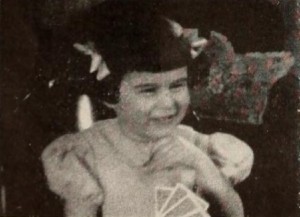
"Two children and a simple plot are ideal ingredients for a family film story. In Magic Stairway, Margaret and Harlan M. Webber have used this combination to develop a lively and natural movie of their son Roy and their daughter Janet. Roy longs for a punching bag for Christmas, but he feels that it is a too expensive gift to expect from his parents. He decides to earn the money for it with the help of his young sister. In beautifully filmed sequences, the children are shown melting castoff candles and remolding them into delicate shapes, to be sold to the neighbors. The profits mount slowly until the desired goal is reached. Then tragedy strikes when Janet accidentally breaks one of Mother's treasured teacups. The direction and cutting in this sequence are particularly skillful, as each person's reaction to the broken cup is registered. All is harmony on Christmas morning when Mother's gift from the children (bought with the punching bag money) is revealed as a replacement of the broken treasure. Needless to say, the children fare handsomely, with the punching bag starring as the climactic present. Faultless camera work and intelligent direction of the children contribute to make this film far above the average." Movie Makers, Dec. 1947, 514.
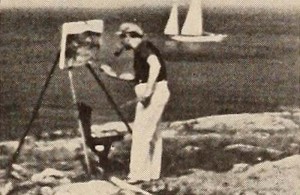
"New England Holiday is the kind of travel film any movie maker should be proud to produce. Replete with human interest and a warm feeling of good fun, this two reel record is distinguished by a wealth of splendid compositions and natural camera treatment. Albert F. Watts has lavished on such typically New England subjects as Gloucester harbor, the fishing fleet or a clam bake the sensitive feeling of an artist for line and mass and the alert understanding of cinematics of a genuine movie maker. Smoothly integrated sequences have been edited with unerring suavity and liveliness, comprising a whole which is both vital and lovely to look at. The production is fundamentally weakened only by a selection of title wordings considerably less spirited and effective than the films which they accompany." Movie Makers, Dec. 1938, 620.
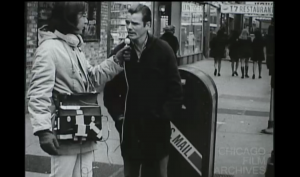
"RATAMATA is a portrait of the diverse opinions of Chicagoans (ranging from high school students to habitual mayoral candidate Lars Daly) as they reflect on the general state of affairs in America, the war in Vietnam, social and racial conflict, freedom and personal liberty, happiness, and social justice." Chicago Film Archives
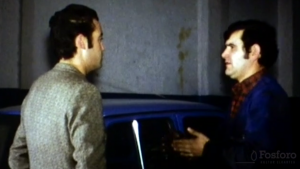
En Noche Buena, un hombre lleva su automóvil a un mecánico para que sea arreglando mientras el camina por una ciudad. Mientras el mecánico trabaja en el vehículo, recibe una llamada telefónica que lo distrae, y después da el coche al hombre, diciéndole que está arreglado. Mientras el hombre está ya en el camino, el mecánico recuerda haberse distraído y no haber apretado los tornillos de la rótula del automóvil, lo cual pone en peligro la vida del conductor. El mecánico intenta contactarlo desesperadamente a través de la policía de caminos mientras imagina que si muere, él será considerado culpable. El conductor eventualmente pierde el control del vehículo y queda varado en un camino solitario, desde donde contacta al mecánico quien agradece a Dios que nada terrible haya pasado. El filme termina con imágenes de luces navideñas en la ciudad y un letrero que muestra la rótula.
On Christmas Eve, a man takes his car to a mechanic to get it fixed while he walks around a city. When the mechanic is fixing the car, he gets distracted by a phone call, then he gives the car to the man and tells him it is fixed. While the man is already on the road, the mechanic remembers getting distracted and not tightening the screws of the car's ball joint, which endangers the passenger's life, so he tries to contact him desperately through the road police and imagining him claiming that his death was his fault. Eventually the man loses control of his car and gets stranded in a lonely road, he contacts the mechanic who thanks God that nothing terrible happened. The film ends with images of Christmas lights in the city and a sign showing the ball joint.
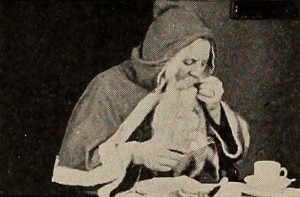
"Santa Passes Out is another of John Martin's delightful pictures of family life, a subject which he handles con amore. A series of unusually fine child studies makes this film outstanding, and the utterly spontaneous character of most of this material is all the more praiseworthy because every bit of it carries the story forward. Mr. Martin did not succumb to the sore temptation that besets the producer parent, to insert an irrelevant shot here and there because it is "so cute." The story itself is a gentle narration of the inevitable expose that awaits the fond parent when he impersonates Santa Claus, and the film as a whole is completely delightful. There is unusually good interior color photography throughout and a very clever, double exposed main title." Movie Makers, Dec. 1938, 597.
"'Santa Visits Elaine,' 16mm. in color, by John E. Pohl of Cicero, Ill., was the winner in the home movies class. The picture is finely done. It greets you with an unusually strong title when it flashes upon you on the screen. No filters are used. There are few characters in the story—as a matter of fact Elaine and her mother carry the greater burden of the cast. To be sure, Santa is in the limelight long enough to do a little tree and interior decorating. Elaine looks a trifle large to accept as gospel truth all the conversation sometimes handed to children about the comings and goings of Santa Claus, but the young lady does or is caused to do one good deed which may indicate one of two things: either she is going to do her utmost to entertain Santa while he is visiting that house or else she has a line on the habits of the male person who is in her mind slated to do the hanging. She very prominently places a bottle of beer and a large glass right where the visitor cannot miss it. Does he miss it? No, he does not. In spite of the obstacle presented by the phoney mustaches he gets around them." American Cinematographer, Jan. 1939, 17.
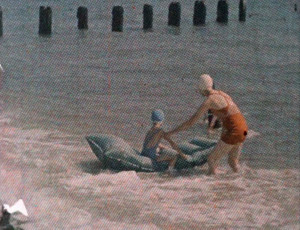
"Nineteen thirties holiday film of the Harrison family at a number of Suffolk coastal holiday hotspots; including Southwold, Lowestoft, the Broads (Beccles), and Thorpeness. This reel, with scenes in both Dufaycolor and black and white, shows the family having a jolly old time bathing, picnicking at their beach hut, horse riding, and sailing. Intertitles include “Susan on the li-lo” and “tea with the mater” (BFI.org.uk)
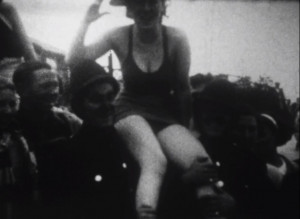
"The excitement of a 1937 holiday starts with the packing of Arthur J. Dawson's initialled suitcase and the train ride from Saltash to Hemsby in Norfolk. Station staff wait to help passengers transfer their luggage to the wooden chalets of Hemsby Holiday Camp. Organised entertainments include following behind a carload of musicians including accordionist, exercising in swimsuits on the beach, silly sports and getting messy with flour and water." (BFI database)
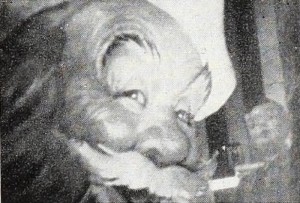
"Most Christmas films seem to be concerned with only one aspect of this December holiday — the gaiety of family life around the tree, opening presents and a festive dinner. Grace Lindner has recorded the material side of the season in the early footage of her film, Xmas Time, as she shows gleaming shop windows, hurrying shoppers, decorated doorways and members of her family around the hearthside. But in a smooth transition from a creche under the tree to the children saying their prayers, she ends her film with a series of architectural studies of the spires and bell towers of churches, filmed through bleak branches against a winter sky. This moving climax, accompanied by a choir recording of The Lord's Prayer, admirably fulfills her aim to portray the triumph of the spirit of Christmas over the baser observances." Movie Makers, Dec. 1951, 412.
Total Pages: 3